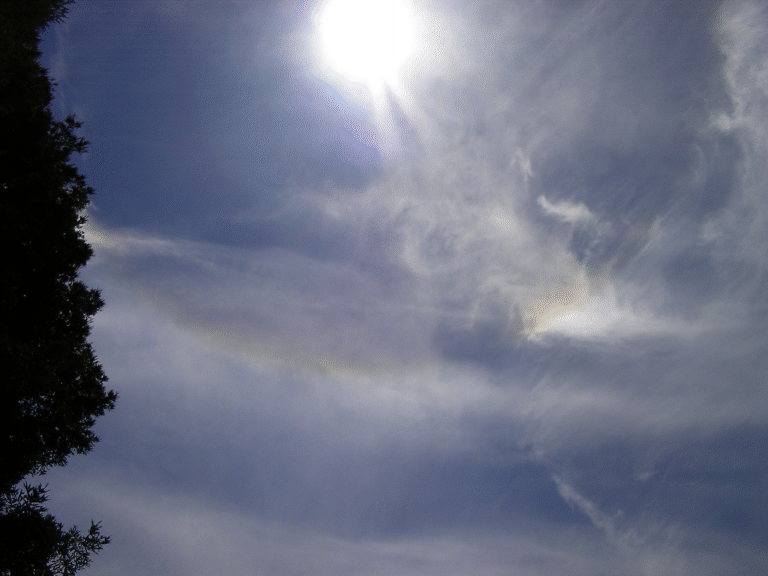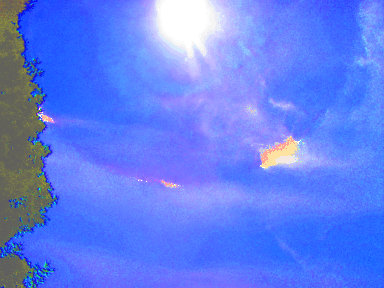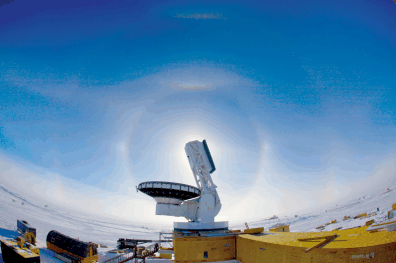
Almost everyone has seen a rainbow. Rainbows are caused by total internal reflection of light, as explained in Encyclopedia Britannica (2006 software edition), or in similar works.

The spectral dispersion of the colors in a rainbow in turn occurs because of chromatic aberration in the droplets of water or other small particles which scatter the light incident upon them. The angle of total internal reflection depends on a transparent material's refractive index; and, for most of the transparent materials, such as water, this varies with wavelength.
A rainbow can occur when water droplets or ice crystals are uniform enough so that many millions of them cause light to be scattered from all at the same angle. This means uniformity of size, for water droplets.
Longer wavelengths (red) are refracted by water at a lower angle than shorter ones (blue), when a boundary between air and water is encountered by light propagating in air. Light comes back by reflection, which is left over from the refraction. So, total internal reflection occurs ar larger angles for longer wavelengths, and this makes a rainbow take on colors with blue on the inside (smaller angle) and red on the outside (larger angle), imagining the center of a semicircular bow to be at the Sun or other light source. Multiple internal reflections can occur; this explanation only applies to the "primary" rainbow, the one created by just one internal reflection.
A more comprehensive explanation may be based on diffractive (wave) optics, applied at the scattering source. When the amplitudes of light of different wavelengths scattered by water or ice in the atmosphere are not in phase, we see more or less light, depending on the actual phase difference. When amplitudes are about in phase but wavelengths are not spectrally selected, so that many sources contribute a mixture of all available wavelengths, we see white light, assuming the original source of the light was white.
The light created at the Sun is a very white light, with equivalent color temperature of about 5800 K -- the temperature of the visible surface of the Sun. However, air, mainly the nitrogen in it, always scatters some of the light from the Sun, even on the clearest days. The scattering removes energy from the scattered wavelengths from the Sun's own image. Conservation of energy.
The molecular scatterers are very uniform in size, but they are smaller than the wavelength of the light incident on them, so they can not be understood in terms in internal reflection. They have no internal "angle", but they do scatter blue light selectively. Because these scattered wavelengths are more or less shorter than those at the Sun's average color temperature, amplitudes at the eye in the Sun's image add more for redder light than blue; and, the Sun, viewed directly (not recommended!) or by light reflected from something white, seems a bit yellower than it would if there were no atmosphere.
Of course, energy is conserved; so, energy from the bluer wavelengths subtracted from the Sun's direct light are multiply scattered by other air molecules and eventually reach the eye from regions of the sky other than that occupied by the disc of the Sun. As a result, on a clear day, the sky looks blue. Without scattered light, it would be black, and the stars would be visible in daylight, just as they are on a clear night.
Uniformity of size (and thus lens-like scattering angle) is the only important geometric factor in rainbows. The actual distribution in the air of the droplets or other particles matters very little, because if the light adds at the eye with the same scattering phase, the color will be the same from every scattering source. The phase changes only with angle. However, if the distribution (concentration) of the scattering sources is small, the rainbow colors will be very weak.
If the distribution makes for a concentrated, dense population of scattering sources, the rainbow will be more visible. When clouds are around, they cause locally big variations of density and so make appearance of a rainbow more likely than otherwise. When density and uniformity cooperate, the rainbow appears.
Energy is conserved. This can be seen in the next photo, which is by a digital camera pointed around noontime, on fairly clear day, almost directly at the Sun. It is unknown whether the Sun's image on the camera CCD sensor array did any damage to the camera; none was obvious.

In this case, the scattering sources were ice crystals in the upper atmosphere. The clouds are cirrus, or maybe altostratus, at an elevation probably exceeding 10 km. These clouds were very thin, so the density of the scattering sources was low, and only the red band is clearly visible.
What is more interesting, if not obvious in the second photo, is the subtraction of energy from the region between the Sun's disc and the rainbow. This was just as apparent to the eye, looking up and slightly away from the Sun's disc, so it is not a photographic artifact. The amplitudes which summed to create the rainbow were compensated by subtraction of those summing in the region between the rainbow and the Sun's disc; so, the entire region between the Sun and the rainbow got a little less light. As can be seen in the photo, this region is distinctly darker than regions at and beyond the rainbow.
In case the difference is not obvious, below is a computer-altered image of the photo above, with color saturation increased to its maximum value in the original (JPEG) image, and lightness then tuned higher until the difference was most evident.

There is some further insight possible into the formation of optical effects such as the rainbow arcs just discussed.
The effect in the photos above depends on random orientation, with no preference of alignment, of the ice particles involved. This is the same as saying that it depends on unbroken symmetry in the plane of the arc.
What happens if the symmetry is broken, is imperfect? This can be seen in the next photo, which was taken in Antarctica with the South Pole Telescope blocking the image of the Sun.

The GIF palette makes the sky a bit webbey in this reproduction. If you can display a TIFF image, use the link in the caption. Otherwise, a very high resolution photo is available at http://www-news.uchicago.edu/releases/07/070226.southpole.shtml.
Because the Sun was almost on the horizon in this photo, the ice crystal clouds were being seen from the side, and the stratification caused the crystals statistically to be oriented preferentially in the plane of the arc. Thus, the symmetry was broken and fragmentary "Sun dog" images of the Sun were formed on the two sides of it, and above it.
The clouds also were thicker in layers, and this caused the rainbow of the arc to be a little brighter in places. Notice the secondary rainbow, which is visible here but was not in the other photos, above.
Conservation of energy, and, by Noether's Theorem, symmetry, may be invoked in many contexts to deepen insight into everyday experiences -- as well into arcane questions such as perpetual motion machines, time travel, or global warming.
Back to Pulfrich Effect Home. University Privacy Policy
The Pulfrich Effect, SIU-C. Last updated 2007-05-26